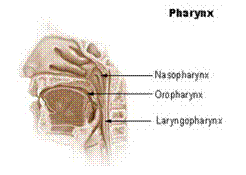Pharynx and Throat Terms
The structures at the back of your child’s mouth and nose perform key tasks that allow your child to breathe, speak, and swallow comfortably. Because of their centralized position within the head/skull itself, the pharynx and throat are interconnected to the ears, nose, mouth and neck. Craniofacial differences often affect them, thus affecting breathing and eating. Be prepared for the important adjustments ahead, by becoming familiar with the parts and performance of these structures.

Adam’s apple
Refers to the hard ‘bump’ pushing outwards from the front of the throat, especially noticeable in men. The bump actually results from extra growth of the protective cartilage covering the thyroid gland; male hormones during the teen years cause this to grow larger and push forward.
Adenoids
Refers to the body of lymphoid tissue lying in the upper back section of the throat, behind the nose.
Adenoidectomy
Refers to a common surgical procedure where we remove the child’s adenoids/lymph tissue located at the back of the upper throat behind the nose.
Articulation
Refers to the process of intentionally forming specific, recognizable speech sounds by movements of the mouth and airway.
Epiglottis
Refers to the small flap of tissue whose job it is to cover the top of the throat airway when the person is swallowing food, keeping food from entering the lungs while your child is eating.
Esophagus
Refers to the thin muscular tube connecting the back of your throat to the opening of your stomach, through which food and drinks must pass in order to be fully digested and assimilated into your system.
Expressive Language
Refers to using speech or printed words to convey your ideas, intentions, emotions, and wishes to other people.
Hearing Impairment
Refers to any amount of hearing loss—from minor difficulty hearing sound ranges, to complete deafness.
Hypernasal speech
Refers to a ‘plugged up nose’ tone of voice; a cleft palate often causes this kind of speech when the soft palate is not long enough or strong enough to properly open/close the back of the mouth for sound and tone control. (hyper=more than normal, nasal= using the nose, of the nose)
Hyponasality or Denasality
Refers to a tone or quality of voice that is missing the normal “m”, “n”, and “ng” sounds, causing the person to speak in a nasal tone of voice as if they had a head cold.
Larynx
Refers to your voice “box”; the structure which produces sound and vibration as you force breath through it out the mouth.
Levator muscle
Refers to the muscle that controls the soft palate’s movement; this muscle is critical to clear speech and efficient breathing/swallowing. Sometimes we call this the ‘veli palatini’. (veli= muscle, palatini = of the smaller palate)
Pharynx
Refers to the inside throat area beginning behind the nose base and extending down the throat to the voice box. The pharynx allows both food and air to pass through separately, with food taking priority during eating. To prevent choking or breathing in of food/liquid particles, the area is structured so that air enters the larynx at the front; during eating, a small flap of connective tissue (epiglottis: epi= above and over, glottis = back of the tongue) covers the airway and the food passes by that entrance, on to the esophagus. Because it is the top of the air passageway, the pharynx helps with speech as well.
- The pharynx has three physical sections:
- The Nasopharynx – the upper portion of the back of the throat, from the line joining the soft/hard palate; down behind the back of the nasal area
- The Otopharynx – the lower portion of the back throat; tonsils, soft palate and uvula form the back wall of otopharnx
- The Laryngopharynx – the area in the back of the throat corresponding to the cervical

Pharyngeal flap
Refers to a surgically created flap of skin tissue that we attach to the far end of the soft palate when the palate is unable to close and open the throat well enough to make specific tones.
Resonance
Refers to the sound quality created by air vibration in the mouth and inner nose.
Salivary Glands
Refers to the several small glands in the mouth which provide a constant flow of salivary fluid to the mouth; it keeps all the tissues moist and helps break down food chemically before swallowing.
Soft Palate
Refers to the soft, fleshy, muscular roof of your mouth, beginning just behind the hard palate and extending toward the back of the throat; extremely important for air control and sound formation when you speak. We also call it the ‘velo’ pharynx because it covers the opening of the top of the throat like a ‘veil’. (The Latin for soft palate is velum= veil-like structure)
Speech Defect
Refers to the speech differences that are not within the normal range of variation.
Tonsils
Refers to the small pair of glands located on either side of the back of the mouth, involved in preventing illness and germs from entering the body through the throat. If they are continuously swollen and sore from continuous colds, allergies or extreme sensitivity, the tonsils can make it difficult to speak and breathe normally; often they’ll be surgically removed.
Trachea
Refers to the long, cartilaginous tube connecting the back of your throat to your lungs for intake of oxygen and exhaling carbon dioxide.
Uvula
Refers to the small cone-shaped extension of tissue at the end of the soft palate, which hangs down
in the center of the back of your throat; it is important for speech production and breathing. When
the soft palate doesn’t reach far enough back or have enough muscular control to close the airway
for speech tones and sounds, we call it velopharyngeal insufficiency or velopharyngeal incompetence
(velo= veil; pharyngeal= of the pharynx; in= not, sufficient= enough, or the right amount); or
(in=not, competent= able to perform normally).
Voice Disorder
Refers to any of a number of different speech/vocal problems: hoarseness, low volume speech, or strained speech.